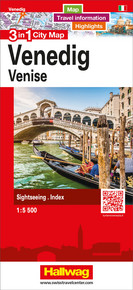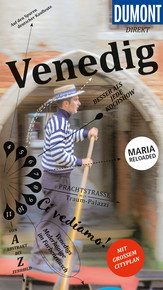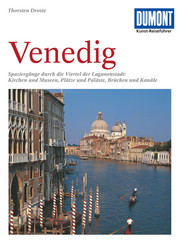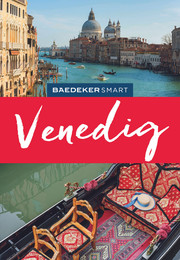Venice casts its spell on everyone. Is it the ancient car-free alleys, palazzi and canals that make it so appealing? Is it the gondoliers who sail you through the canals or the delicious Venetian delicacies? Probably it is precisely this mix. If, like the Venetians, you relax and enjoy the lagoon city, you will always have fond memories of this city break.
For me, a relaxed long weekend in Venice begins at Bern train station. Equipped with a delicious sandwich, a large bottle of water and a travel guide about the much-cited lagoon city, I sit down in an SBB carriage compartment and enjoy the journey to the north-east of Italy. It takes a good 6 hours to reach the capital of Veneto. Directly at the station square, numerous vaporetti are already waiting to chauffeur tourists from all over the world by water to the various districts and accommodations. Venice was built on more than 100 islands, which are connected by around 400 bridges. There are no cars in Venice. Really none at all! Venice is connected to the mainland by a bridge, but immediately afterwards it's a case of: Please park your car. That's why a city trip to Venice by train makes the most sense. You can only get around Venice on foot or by water bus; there are about 175 canals with a total length of 38 kilometres. However, the large amount of water also poses great dangers: "Acqua alta", or high water, is the name of the natural phenomenon that regularly floods parts of Venice. The consequences of climate change and the resulting rising sea level are devastating for Venice. Scientists assume that it is only a matter of time before Venice will sink. Even without climate change, the lagoon city seems to be sinking - from crowds of people. The monstrous cruise liners that were still allowed to dock at St Mark's Square until 2021 were not the least to blame. That has eased with the pandemic. However, if you plan a little cleverly, you can avoid the streams of tourists. So I settled in Murano, in an affordable flat for Venice with a view of the water and the lighthouse.

Venice is comparatively manageable - both in terms of area and the abundance of important sights. It is the special flair of Venice that makes the city so special. If you stay two nights, you can easily explore the most important sights in Venice. If you plan to visit one or two museums or take a trip to Burano, we recommend staying an extra night. The most famous square in Venice is a must-see on a city trip to Venice. The dimensions of St Mark's Square are gigantic: it is 175 metres long and 82 metres wide. You only realise how incredibly spacious Piazza San Marco is when you stand in front of it. The central building on St Mark's Square and undoubtedly the most important church in Venice is St Mark's Basilica. From the outside as well as from the inside, it is a true masterpiece of architecture and leaves you in awe. The five enormous domes and the ornate façade, influenced by the Byzantine architectural style, catch the eye.


Directly adjacent to St Mark's Basilica, the next top sight awaits: the Doge's Palace. This pastel-coloured building was once the seat of the Doge - the head of state of the Republic of Venice - and thus the centre of power in Venice. The building is correspondingly pompous. If you have enough time, you should also visit the rooms of the Doge's Palace. A tour of the state rooms immerses you in Venetian history. A sight that seems inconspicuous at first glance awaits you right next to the Doge's Palace: the Bridge of Sighs. This eleven-metre-long, covered bridge made of limestone connects the Doge's Palace with the former prison and spans the picturesque Rio di Palazzo canal. The unusual name of the bridge is no coincidence: according to legend, the prisoners gave one last sigh overlooking the Venetian lagoon on their way to prison. Even more famous than the Bridge of Sighs and one of the city's most important sights is the beautiful Rialto Bridge, which spans the Grand Canal - Venice's most important canal, which winds through the old town in the form of an S-curve. A stroll across the Rialto Bridge is a must on any visit to Venice. Not far from the bridge, a visit to the Mercato di Rialto is also worthwhile. On Saturdays, the locals meet here at the Al Mercà bar and order an aperitivo with tasty little snacks.

Right next to the bar is a cheese dairy, the Aliani Casa Del Parmigiano. Why not bring home a delicious Parmigiano for your loved ones? Or pay a visit to the bookshop Libreria Acqua Alta, where you can also find nice souvenirs to take home. In the middle of the room stacked to the ceiling with books, there is a gondola that is also filled to the brim with books. In the backyard, you absolutely have to climb on the huge pile of old books and look out over the canal. Another postcard motif awaits you with the Ponte dell'Accademia in the south of Venice. The bridge is by far not as famous as the Rialto Bridge, but it gives you one of the most famous photo motifs in Venice: the Grand Canal with the Basilica di Santa Maria della Salute. Not a classic sight, but still one of the great highlights for many is a gondola ride through Venice. The singing gondoliers belong to Venice like the Eiffel Tower to Paris. Sailing through the canals of Venice in a historic gondola is an (expensive) experience, but one that will certainly be remembered for a long time. Free of charge and no less spectacular is a visit to Venice's narrowest alley. Calle Varisco in the Cannaregio district is just 52 centimetres wide. This makes it one of the three narrowest streets in Europe. And Venice has another unique feature: the Ponte Chiodo is the only bridge without railings.


If you are looking for authentic Venice, you will find it in the Dorsoduro district. You will notice that the university district is popular with young people at the latest when you go to Campo Santa Margherita for an aperitivo. This spacious square is home to countless bars and restaurants, which are particularly busy in the evening. My tip: For an aperitivo, go to the Osteria Al Squero. Here you can get Venetian tapas, so-called cicchetti with a free view of the canal and the old gondola shipyard, where you can watch the workers building the world-famous gondolas. And another culinary tip if you're into sweets: In the tiny, authentic "Pasticceria Dal Nono Colussi", Venetian specialities have been baked for over 60 years. Here you can get, among other things, the "fugassa veneziana" - a Venetian speciality reminiscent of panettone.
For those who would like to take a souvenir photo from a bird's eye view, the roof terrace of the popular shopping centre T Fondaco dei Tedeschi is recommended. Located directly above the Rialto Bridge, it offers a fantastic 360-degree view. The great thing about it is that access is completely free, only a reservation for the desired timeslot is necessary. A beautiful picture with St Mark's Square can be taken from the bell tower of the Benedictine abbey Chiesa di San Giorgio Maggiore on the island of the same name.

Venice has a lot to offer in terms of cuisine, even if most of it is not cheap. On St Mark's Square, an espresso costs a whopping 6.50 euros! But it can also be cheaper. For example, at the Farini. This bakery chain with delicious pizzas has several locations in Venice - including one near the Rialto Bridge on the way to St Mark's Square. Gelato di Natura and Gelatoteca Suso offer delicious ice cream. For dinner, we recommend Salvmeria: The converted delicatessen serves accomplished dishes. Stockfish on polenta, marinated shrimp or Fassone beef with peppers.
Be sure to plan a trip to the two islands of Murano and Burano. On Murano, the traditional art of glassmaking is omnipresent. In the Museum del Vetro you can learn more about the history of glassmaking and view the glass art. Also worth seeing is the Basilica dei Santi Maria e Donato - one of the oldest churches in the lagoon.


Colourful. More colourful. Burano! Perhaps you have seen a photo of the colourful houses of the fishing village of Burano? The friendly island is rightly one of the most popular destinations in the region. Burano covers the entire colour palette: Rust red, violet blue, mint green - Burano is not considered the most colourful island in the world for nothing. And on Burano, the craft tradition of lace embroidery is still cultivated today. Why are the houses so colourful? According to a legend, the fishermen once painted their houses in the brightest colours to provide better orientation. According to popular myth, this made it easier for them to find their home port in the fog or after a night of drinking.
By the way: from the Tre Ponti Bridge you can enjoy the postcard view of Burano. Nearby, you can enjoy a beautiful sunset at the Old Fish Market in the café of the same name. A la prossima Venezia!

To properly prepare for your trip
How to get there:
By train www.sbb.ch in just over 6 hours
How long to plane:
2 - 3 days
Best time to travel:
All year round
How to get around:
Vaporetti day ticket
Highlights:
Burano, cruise on the Grand Canal, St Mark's Square, Murano and its glass art.
Accommodation Tip:
Lagoon Skyline on Murano via www.airbnb.de
More Info:
www.visitvenezia.eu
Realised by Michael Bachmann
Further travel pictures under www.kissed-by-nature.com






























